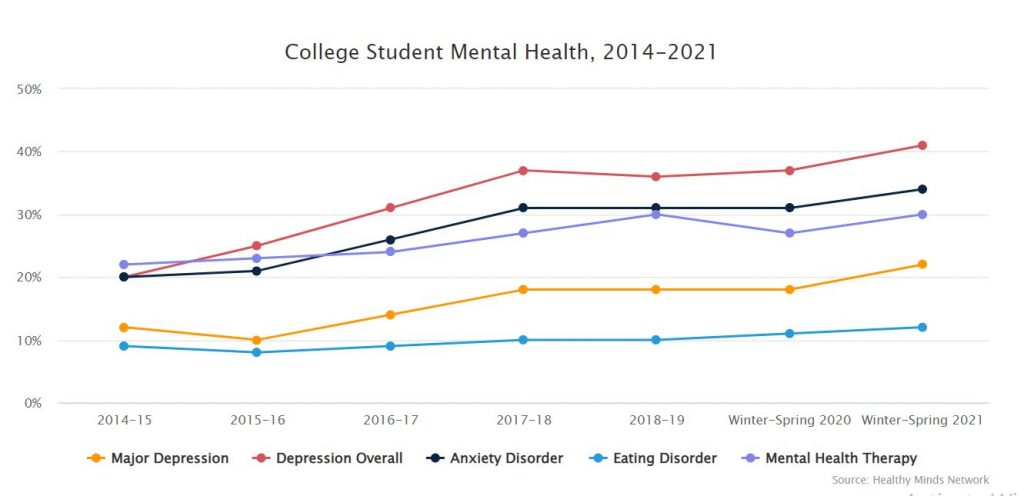According to the research data, students often experience mental health conditions like stress and anxiety during their academic studies. This article will walk you through the best mental health coping strategies for balancing your health and studies.
In the late 1980s, around 10-15 percent of the U.S. population had clinically significant mental health illnesses. Now, that figure is closer to 25-35 percent. Over the last thirty years, there has been a nearly threefold increase in mental health crises. These rising trends indicate that young adults, particularly college students, are the most likely to experience mental health issues.
Mental health concerns are growing among students
The annual Healthy Minds Study data showed that the prevalence of mental health conditions among college students is rising. Note that between 2014 and 2021, college students exhibited an increase in anxiety rates by 14 percentage points (20 percent vs. 34 percent), while rates of depression increased by 21 percentage points (20 percent vs. 41 percent).
At the same time, we have observed changes in students’ attitudes toward mental health, with many of them displaying an increased willingness to seek medical assistance and counseling services.

The most commonly reported mental health illnesses among college students are anxiety and related conditions, including increased mental vigilance, chronic stress, and inability to cope with difficult situations. We’re also witnessing a significant increase in suicidal ideation and general self-harm.
Both graduate and undergraduate students have similarly high rates of cognitive health conditions. Nevertheless, research studies indicate that graduate students are more likely to experience severe mental health conditions due to an increased workload and difficulty finding a work-life balance.
Finally, the challenges of the COVID-19 pandemic may have contributed to the recent rise in mental health conditions among college students.
Three best coping strategies to deal with mental health conditions
College students may experience a variety of mental health conditions, including depression, burnout and stress, anxiety, and eating disorders. The following are some best mental health coping strategies that college students can use to improve their mental health.
1) Conduct regular self-assessments
College students should regularly conduct thoughtful, honest, and reflective evaluations of themselves. During the check-in process, you must ask yourself the following questions:
- What exactly is my emotional and social state?
- Does my life have goals, and am I making progress?
- Am I happy and satisfied with my life?
- Do I feel valued and known by the people who matter most in my life, including myself?
- Do I have any medical health conditions like anxiety, stress, or depression?
Answering these questions will help you maintain good mental and physical health. If you are unsure how to respond to them, consider taking a wellness assessment.
2) Employ the three A’s
Students can cope with mental health conditions by employing the three A’s strategies listed below.
i) Awareness
ii) Acceptance
iii) Active change
The goal of awareness is to better understand what is happening, particularly in terms of your feelings, actions, thoughts, and relationships. Acceptance is the ability to tolerate and hold negative emotions and distressing situations in a sensible way. And active change entails trying new things, even if it is difficult to do so.
If you have mental health problems, we encourage you to become more self-aware and identify the negative emotions you are coping with, including the causes of those emotions and how to respond to them.
We also recommend improving your ability for Acceptance. Acceptance of painful feelings and past losses is part of this process. Likewise, you can increase your interaction with people and other things—even if your initial reaction is to avoid and pull back.
These are not always easy steps to take. You might want to consider other alternatives such as therapy, talking to a loved one, self-assistance, or a combination of support services and resources.
3) Use CALM MO to practice mindfulness
Students dealing with conflict or other mental health conditions in their lives can benefit from the acronym CALM MO. This concept has something to do with psychological mindfulness.
The term “CALM” indicates the observer’s mindset, which we can all strive to achieve. The letter “C” stands for curiosity, which can lead to questions like “What is going on?” or “How do I feel, and why do I feel that way?”
The CALM MO is an abbreviation of:
Curiosity
Acceptance
Loving
Motivation
Meta-Cognitive
Observer
The letter “A” stands for acceptance, which means your acceptance of situations, feelings, experiences, and other people. “L” represents a loving, compassionate attitude toward oneself and others, while the letter “M” denotes motivation for valued states of being. Furthermore, the MO part refers to the meta-cognitive observer. or the ability to divert our attention from what we’re doing to what we’re thinking and feeling.
We recommend that students use the “CALM MO” method to promote their mental and physical health and overcome future challenges. You can also get more information about stress management strategies by clicking here.

